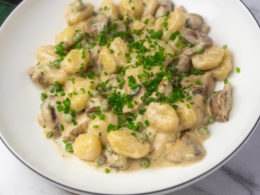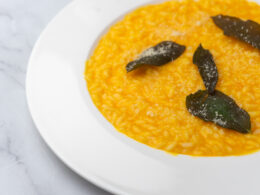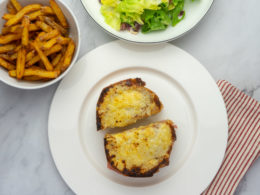Real beer battered fish and chips is a British staple and it’s the food that I really miss in Paris. Voted by the British public as one of the most British dishes, it’s distinctly emblematic of our cuisine. Typically served with thick cut chips (or thick fries), tartare sauce, mushy peas and a wedge of lemon, it’s incredibly satisfying and found all over the UK (even Paris too!).
If you’ve eaten fish & chips before then you know it can be hard to do properly. Mushy batter and overcooked fish turn it from an incredible dish to something very disappointing. Our recipe has a few techniques and tricks to ensure that you’ll end up with incredibly crispy batter and moist, flaky fish. We’ll also tell you how to make the most amazing thick cut British chips (fries).

Classic British Fish & Chips
The dish dates back to the early 1800s and historians believe the first fish and chip shop was started in either London or Manchester at around the same time. Nowadays it’s found in every pub and British restaurants around the country and it’s a dish I absolutely love to eat when I’m back at home in the UK visiting family and friends.
So how hard is it to create at home? Actually pretty easy – you just need to be able to deep fry. This can be daunting to the home cook but it’s actually really easy and can be quick and relatively mess free. Check out our guide on how to deep fry at home below.
Real British Chips
For a real fish & chips you need to make proper chips. These are the equivalent of thick French fries and they should never be skinny. To make really crisp chips which are fluffy in the side you’ll need a floury potato. The best potatoes to use for chips/thick fries are:
- USA & Canada:Russet
- UK: Maris Piper
- France, Belgium: Bintje
- Australia: Russet Burbank
The key to getting the best chips are to triple cook them. This sounds like a lot but it’s pretty easy and doesn’t take too long. You can also do the first 2 cooks in advance and freeze them for use later.
For the first cook is in salted, lightly simmering water. This step helps break down the edges of chip ensuring you get crispy edges when you fry in oil. The chips are then let to steam dry and then put into the fridge to solidify the starch and dry them out even more.

The second cook is a deep fry at a low temperature of 130c/266f for 7-8 minutes. This is to form a crust around the edge of the chip and to ensure the middle of the chip is completely cooked resulting in a very fluffy interior. These are again left to cool and placed in the fridge. At this point you can freeze them for use later – it won’t affect the quality of them at all.

Finally, the third and final cook is to deep fry at a high temperature at 180c/356f. This final cook gets the edge of the chip super crispy whilst heating up the centre. The resulting chip is incredibly crispy whilst fluffy in the centre – they’re awesome.

If you don’t want to bother with making your own chips then you can buy frozen thick cut fries and fry directly. Alternatively you can use oven chips if you only want to fry the fish.
Crispy Beer Battered Fish
A big part of cooking a good fish and chips is getting the batter right. Airy, crispy batter is a glorious thing which creates a casing for the fish to steam gently in resulting in flaky, moist fillets.
This section will walk you through which fish to choose, how to prep it and how to make a really good batter.
What Fish to Use for Fish & Chips?
Fish and Chips in the UK generally use either boneless and skinless Cod or Haddock fillets. These are both firm white fish and are excellent to be battered and fried! For the best fish for beer battered fish, i’d recommend:
- Cod
- Haddock
- Pollock
- John Dory
- Turbot
- Halibut
- Plaice
Don’t use oily fish such as:
- Mackerel
- Salmon
- Tuna
- Sardines
Also avoid using spiny rockfish such as Gunard, Rascasse or Skate.
Salt the Fish
One great tip to ensure that your batter stays crispy is to salt, or cure, the fish before you fry. This is really simple and makes a big difference and it only takes 10 minutes. The salt draws out excess moisture within the fish leaving a firm, well seasoned fish fillet that won’t make your batter soggy.
Simply cover your fish fillet with a lot of kosher or fine sea salt, ensuring all sides are covered. Reserve the fish fillets in the fridge for 10 minutes. You’ll notice a lot of liquid has been drawn out of the fish! Rinse the fish under cold water to remove the salt and pat dry with kitchen paper. Your fish is now ready to fry!

The Best Beer for Beer Batter
I find that lager is the best beer to use in beer batter and it needs to be as cold as possible. This really helps with the end crispiness. CO2 is more soluble at colder temperatures meaning that you’ll get an airier and crispier better.
It’s also important to open the beer at the very last minute to ensure that as much as gas stays in the liquid as possible.
Avoid using IPAs the strong citrusy flavours from the hops are too strong in the batter. Also avoid using Porters or Stouts as they’re too heavy.

Beer Batter for Fish
So now you’ve got your fish, cured it for frying and selected the right beer – now it’s time to prepare the batter. An airy and light batter is down to the flour and the all important beer. So what makes for a really good beer batter for fish?
- Flour: The base is a 50:50 mix of all-purpose/plain flour and cornstarch. Why the cornstarch? The cornstarch inhibits gluten development which keeps the batter nice and light as opposed to tough and chewy.
- Salt and baking powder: Baking powder is a leavening agent which helps puff up the batter. It works in combination with the beer by releasing carbon dioxide resulting in super airy batter. Salt seasons the batter!
- Beer: Beer adds carbon dioxide to the mixture and also a lovely flavour. The CO2 (or bubbles that you’ll see) aerates the mixture leaving it light and airy.

Frying Your Fish
Getting your batter crispy isn’t too hard and it’s all about oil temperature. Getting the oil to 170-180c/340-356f is key. Any lower than this and the batter will be soggy, any higher and it’ll brown far too quickly.
Once the oil hits temperature, slowly lower the battered fish into the oil – DO NOT drop the fish into the oil! Once the fish is in the oil, take a spoon and drizzle the exterior of the fish with extra batter. Doing this will add even more crunch to the fish. Do not overcrowd the pot as it will cause the oil temperature to drop!
Frying will take at least 3-4 minutes but you’ll want to check the fish with an instant read digital thermometer. You’ll want to pull the fish out when it hits 45c internal temperature. This will rise to 55c when rested for a few minutes. By doing this you’ll get perfectly moist, flaky fish.

Mushy Peas & Tartare Sauce
You have to serve a classic fish and chips with the right accompaniments! Tartare sauce is an awesome condiment to go with fried fish and mushy peas is one of the few healthy components in the dish!
Mushy Peas or Pea Purée?
Mushy peas are the classic side to go with fish and chips. Traditional mushy peas aren’t made with the ubiquitous garden pea or petit pois, they’re actually made with dried Marrowfat peas. These are stewed in water and their high starch content provides the signature thick consistency. Many chippy shops then season them with malt vinegar. If you want to make authentic mushy peas check out our recipe for them below:
If you don’t want to go to the trouble of making your own mushy peas then making a pea purée is a great, cheap alternative. Check out our recipe for pea purée below:
A Classic Tartare Sauce
Tartare sauce is must have with fish and chips. It’s creamy yet balanced with beautiful acidity from the capers, cornichons and lemon juice. A simple tartare sauce will have:
- Mayonnaise (store bought is fine)
- Capers, finely chopped,
- Shallots, finely minced
- Cornichons, finely minced
- Parsley, finely chopped
- Chives, finely chopped
- Lemon juice
Simply mix all the ingredients together, season to taste and voilà you’ve got a fantastic tartare sauce.

Ingredients
Makes 2 portions (double amounts for 4)
- 2 skinless Cod fillets, around 150g each
- 50g plain/all purpose flour, plus extra for coating the fish
- 50g cornstarch
- 150g lager, cold
- 1/4 tsp baking powder
- 3 large potatoes
- Vegetable oil, for frying
- Tartare sauce, as required
- Pea purée, as required
How to Make Fish and Chips
For the chips:
- Peel your potatoes and cut off any knobbly or very rounded ends. Slice the potatoes so you have 2cm/0.75inch thick rectangles.
- Soak the chips in cold water to remove excess starch
- Bring a pot of salted water to boil and add your chips. Reduce heat to a bare simmer and leave uncovered. Simmer the chips for 8-10 minutes or until you see that the edges are starting to break up.
- VERY carefully remove the chips with a slotted spoon or spider and let them cool on a cooling rack. When at room temperature, put them in the fridge or freezer for at least 30 minutes – ideally 2 hours.
- Heat up a fryer or a pot of oil to 130c/266f and fry for 7-8 minutes or until a light golden crust has formed. Remove with a spider and let them cool on a cooling rack. Reserve in fridge until you’re ready to fry the fish.
- When you’re ready to eat, heat up the fryer to 180c/356f and add the chips. Fry for 3-4 minutes or until crispy and golden brown. Remove and place on kitchen paper to soak up excess oil. Season with salt immediately.
For the fish:
- Start by curing the fish. Liberally salt the fish fillets with fine sea salt and place in the fridge. After 10 minutes liquid should have leached out of the fish. Rinse the fish to remove excess salt and pat dry. Reserve in the fridge
- Heat up your fryer/pot of oil to 180c/266f.
- Mix the dry batter ingredients and, only when you’re ready to fry, open and add the fridge cold beer. Mix quickly to avoid removing too much of the gas. Note that lumps are fine and actually add texture!
- Coat the fish in a thin layer of flour and shake to remove excess. Place the fish into the batter ensuring it’s completely covered.
- Place the battered fish in the fryer and fry 4-5 minutes checking with a digital thermometer until the fish hits 45c. Remove and season immediately.
- Serve fish immediately with chips, mushy peas and tartare sauce.
Can it be Reheated?
Unfortunately fish and chips really don’t reheat well if there are leftovers. You can reheat a whole beer battered fish in the oven but don’t expect a particularly crunchy exterior or moist fish. The chips can be reheated in the oven but again, they won’t be the best.
Fish and chips is best enjoyed fresh out of the fryer!
Can You Make it in an Air Fryer?
Unfortunately you can only make wet battered fish in a fryer. An air fryer is effectively a small oven and it will never get batter crispy!
You can however make chips in an air fryer but this recipe is adapted to frying.














